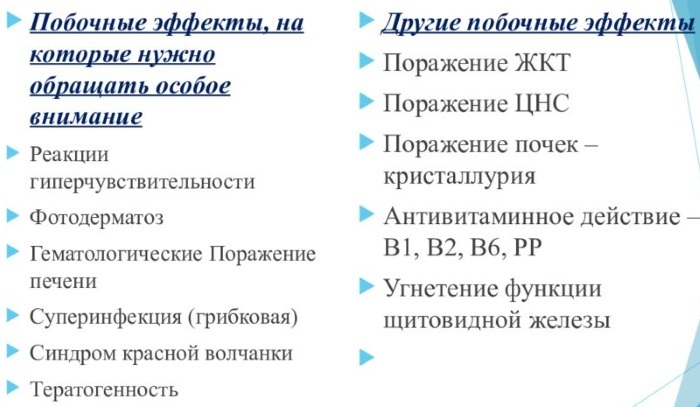3rd generation antibiotics - these are the latest antibacterial drugs that help to effectively fight infections. The list of antibiotics is regularly updated with new drugs, and this is because most pathogenic microorganisms have the ability to adapt to the effects of drugs.
Because of this feature, pharmacists have to look for new substances that have a detrimental effect on bacteria that cause infectious diseases.
The composition of antibiotics includes natural and artificial ingredients that help to provide a directing effect on the suppression of the activity of microorganisms. The first antibiotics were obtained from molds, and then the composition was simply supplemented with other excipients that enhance the effect.
Record content:
- 1 Classification
-
2 Top 10 drugs from the pharmacy
- 2.1 Sumamed
- 2.2 Amoxiclav
- 2.3 Claforan
- 2.4 Cefixime
- 2.5 Avelox
- 2.6 Cefoperazone
- 2.7 Lincomycin
- 2.8 Zedex
- 2.9 Suprax
- 2.10 Fortum
- 3 Antibiotic videos
Classification
Antibiotics of 3 generations (the list includes drugs presented in the form of tablets, injections, powder, suspension) are divided into types. The classification takes into account: the mechanism of action on the human body, the form of release and a few more basic properties. In the table below you can find out the features of the latest generation antibiotics.
| Classification | Peculiarities |
| Release form | Most of the 3rd generation antibiotics are available in tablet form for oral administration. But if the composition includes components that are poorly absorbed by the intestines, then these drugs are produced in the form of a solution intended for injection into a muscle or vein. In rare cases, antibiotics may be injected into the spinal cord canal. If the patient has ailments that have affected the intestines, then rectal administration is possible. |
| Mechanism of action | The antibiotic is divided into two types: bacteriostatics and bactericides. The first group is aimed at inhibiting the activity of microorganisms, as a result of which they lose their ability to reproduce, subsequently they activate the immune system, destroying the remnants of bacteria. But the second group has a detrimental effect on the internal structure of microorganisms, as a result of which they die. Preparations from the latter group act quickly, but they also destroy the beneficial microflora in the intestine. |
| Impact spectrum | In the treatment of infectious ailments, specialists prescribe drugs of a wide or narrow spectrum of action. Broad antibiotics are prescribed in cases where the causative agent of the disease could not be identified, and narrow therapy is prescribed when the pathogen is alone and its type is precisely established. |
Top 10 drugs from the pharmacy
Antibiotics of the 3rd generation (the list includes drugs that include substances that are active against gram-negative and gram-positive microbes) fight the first group of microorganisms that cause intestinal diseases, inflammation of the respiratory system and urogenital systems.
And the second group of microorganisms often causes infection of wounds and provokes complications after surgery.
There are a number of antibiotics that are active in protozoal infection, these include drugs, the active substance of which is nitroimidazole.
The therapist should select an antibiotic after examining the patient and identifying the individual characteristics of the patient. Many drugs have numerous contraindications and often provoke allergies.
Sumamed
Antibiotics of the 3rd generation (the list is headed by a bacteriostatic drug belonging to the macrolide-azalide group) suppress the protein synthesis of microorganism cells, slowing down growth and reproduction. At high dosages, it can have a bactericidal effect.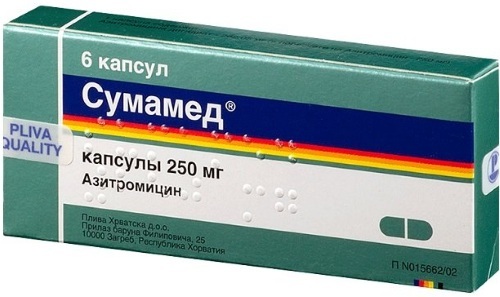
Summamed is active against gram-positive, gram-negative, intracellular, anaerobic and other types of bacteria.
The drug is produced in the form of a white powder, intended for the preparation of an infusion solution. The active component is azithromycin dihydrate, which easily penetrates from the blood serum into the cells of the body, easily migrates to the focus of inflammation, accumulating in the tissues affected by the infection. Citric acid and sodium hydroxide act as additional components.
An antibiotic is prescribed for:
- severe pneumonia;
- inflammation and infection of the pelvic organs.
The drug is administered only by intravenous drip for 3 hours. Cannot be injected. In severe pneumonia, the drug is prescribed in a dosage of 500 mg 1 time per day for at least 2 days. By decision of the specialist, the course can be extended up to 5 days. After intravenous administration, the doctor may recommend oral administration, but this is individual for each patient.
The infusion solution is prepared as follows:
- Add 5 ml of water for injection to a bottle with a concentration of 500 mg azithromycin, shake well to completely dissolve the powder.
- Use the solution immediately after preparation.
A reconstituted solution can be prepared; for this, sodium chloride, dextrose or Ringer's solution is used as a solvent.
Among the undesirable manifestations after Summamed therapy, such pathologies can be observed: candidiasis, colitis, gastroenteritis, rhinitis, anemia, anorexia, anaphylactic reaction, headache, dizziness, blurred vision, decreased blood pressure, flushing, shortness of breath, nosebleeds, pancreatitis.
You can not use Summamed for therapeutic purposes with:
- intolerance to the components that make up the composition;
- sensitivity to erythromycin;
- disorders of the liver and kidneys;
- carrying a fetus and breastfeeding;
- children under 18 years old.
Do not prescribe the drug while taking ergotamine and dihydroergotamine.
Take medicine with caution when:
- myasthenia gravis;
- the presence of proarrhythmogenic factors;
- taking antiarrhythmic drugs;
- violations of water and electrolyte balance;
- severe pathologies of the heart.
You can buy the medicine at any pharmacy without any doctor's permission, the average price varies from 300 rubles.
Amoxiclav
It is a combined antibiotic that contains amoxicillin and clavulanic acid. The medicine has bactericidal properties, inhibits protein synthesis of microorganisms.

The drug actively fights against gram-positive and gram-negative microorganisms. As additional components, colloidal silicon dioxide, crospovidone, magnesium stearate, microcrystalline cellulose, sodium croscarmellose are used.
The therapist prescribes the medicine for such ailments:
- infectious lesion of the respiratory system;
- ENT infections;
- infection of the genitourinary system;
- infections that have affected the skin and soft tissues.
Also, the medicine is prescribed for prophylactic purposes during surgery. The dose and duration of therapy is selected by the doctor, depending on the severity of the disease and its localization.
For children, the drug is prescribed in the form of a syrup, suspension or drops of 30 mg per 1 kg of body weight. The dose is divided into 2 doses per day. The dosage may be increased for serious infections up to 45 mg. Adults and adolescents from 12 years of age are recommended to take the medicine in tablet form 500 mg 2 times or 250 mg 3 times. The average duration of therapy is no more than 2 weeks.
During therapy, patients may experience undesirable manifestations: nausea, vomiting, stomatitis, gastritis, leukopenia, thrombocytosis, headache, dizziness, convulsions, an allergic reaction.
The drug is not recommended for:
- sensitivity to components;
- infectious mononucleosis;
- violations of the liver;
- phenylketonuria.
Take with caution during childbearing, lactation, stomach and intestinal diseases, liver failure. The medicine is produced in film-coated tablets, in the form of a suspension, syrup, drops for oral administration. You can buy the medicine in the public domain for 150 rubles.
Claforan
Antibiotics of the 3rd generation (the list is huge) include Claforan, a semi-synthetic drug from the group of cephalosporins. The medicine is designed for parenteral use. Possesses bactericidal properties, resistant to more β-lactamases. The drug actively fights against many pathogens that provoke infections and inflammation.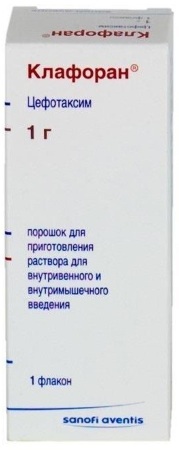
The main component is sodium cefotaxime. It is produced in the form of a powder intended for the preparation of a solution introduced into the body through a muscle or vein.
Prescribe a medicine for:
- infection of the respiratory system;
- infections affecting the genitourinary system;
- septicemia;
- bacteremia;
- endocarditis;
- meningitis;
- infection of the skin and tissue;
- infections affecting bones and joints;
- prevention in surgery.
The drug is administered by injection or infusion into a vein or muscle at a dose of 0.5-1 g once. The dose can be increased depending on the complexity of the course of the disease. The course and dosage are selected individually.
Prepare the solution as follows: 1 g of powder is diluted with 4 ml of water for injection, and 2 g in 10 ml. If the drug is injected intramuscularly, then lidocaine 1% can act as a solvent.
Drug therapy can provoke undesirable manifestations, manifested in the form of an allergic reactions, nausea, vomiting, abdominal discomfort, worsening urinary flow, neutropenia, arrhythmias, fever, weakness.
The drug is not recommended for people with special sensitivity to cephalosporins, pregnant and lactating. The medicine is sold freely for 40 rubles.
Cefixime
Antibiotic of the 3rd generation from the list of drugs of the cephalosporin group. The medicine is active in the treatment of infectious pathologies, which has bactericidal properties.
The drug stops reproduction and destroys the vital activity of many gram-positive and gram-negative bacteria. The medicine is produced in bottles of 125 ml, which contains 100 mg of cefixime and 26 g of powder with a pleasant strawberry smell. Also, the drug is presented in tablet form, 200-400 mg.
The main component of both forms is cefixime, but the additional components are different:
- the tablets include titanium dioxide, sodium starch glycolate, magnesium stearate, cellulose, dicalcium phosphate dehydrate;
- the solution contains sucrose, silicon dioxide, strawberry flavor, xanthan gum, sodium benzoate, sodium hydroxide.
Prescribe a medicine for infections that hit:
- upper and lower respiratory tract;
- ways of excretion of bile and urine;
- skin and soft tissues;
- ENT organs;
- bones;
- female genital organ.
The drug in tablet form is prescribed for children less than 50 kg at 8 mg per 1 kg of body weight 1 time per day. For adolescents and adults over 50 kg, the dosage is 400 mg, divided into 2 doses. The duration of therapy is up to 7 days.
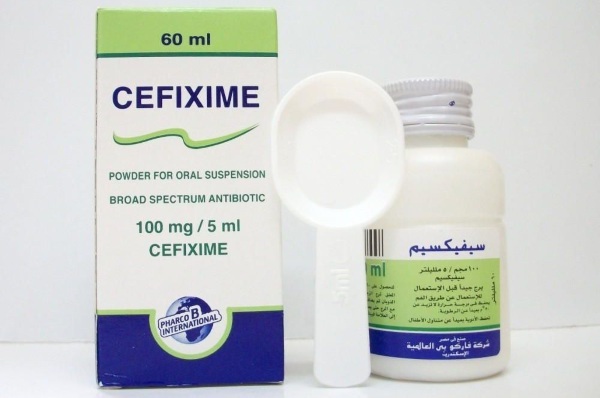
A suspension is prepared from the powder; for this, purified water should be poured into the bottle to the volume indicated on it, shake well. Therapy in some patients can cause such manifestations: allergies, Stevens-Johnson syndrome, erythema multiforme.
Do not prescribe a medicine for intolerance to the main substance. The drug is not compatible with alcoholic beverages. The average cost of two forms of the drug is from 450 rubles.
Avelox
It is a broad-spectrum antibacterial drug with bactericidal properties.
The main component of the drug is moxifloxacin, which inhibits bacterial topoisomerases, which ultimately provoke violations of the processes of replication, repair and biosynthesis of DNA of microbial cells, which ultimately provokes death bacteria. Cellulose, magnesium stearate, lactose monohydrate, croscarmellose sodium act as additional components.
Prescribe the drug for infection and inflammatory processes that were caused by the presence of bacteria sensitive to the main component:
- sinusitis;
- chronic bronchitis in acute form;
- pneumonia;
- skin and soft tissues;
- intra-abdominal abscesses;
- inflammation of the pelvic organs.
The medicine is produced in tablet form and is taken orally at 400 mg 1 time per day, the duration of therapy is no more than 10 days. In some of the most difficult cases, the duration of therapy can be up to 3 weeks.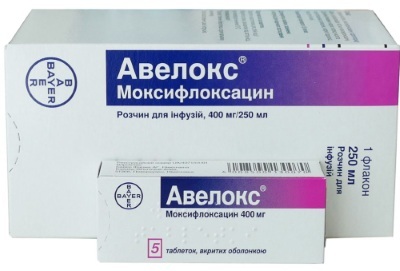
During therapy, if the recommendations are not followed, the following manifestations may occur: nausea, diarrhea, anemia, increased prothrombin in the blood, allergies, anxiety, panic attacks, visual impairment, dizziness, headache pain.
Do not prescribe medicine for pathologies affecting the tendons, heart problems, intolerance lactase, pregnancy, liver disorders, lactation, children under 18 years of age, intolerance to components composition.
The drug is prescribed with caution to people with ailments that have affected the nervous system, cirrhosis of the liver, and ischemia of the heart. Avelox tablets are sold in pharmacies for free for 1000 rubles.
Cefoperazone
It is an antibiotic from the group of 3 generation cephalosporins with a broad spectrum of action. The drug inhibits protein synthesis in the cells of pathogens.
Cefoperazone, which acts as the main substance, disrupts the cross-linking of peptidoglycans, which ensures the strength of the cell walls of microorganisms. The drug is active in aerobic, anaerobic gram-positive and gram-negative bacteria.
A preparation is produced in the form of a powder, intended for the preparation of a solution that is injected into the body into a vein or muscle. An antibiotic is prescribed for infections and inflammation, which were triggered by the presence of bacteria in the body that are sensitive to cefoperazone.
Such ailments include:
- peritonitis;
- pneumonia;
- cholecystitis;
- acute form of bronchitis;
- meningitis;
- sepsis.
For preventive purposes, the drug is prescribed in surgery.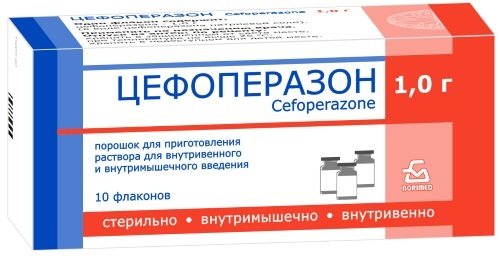
The drug is administered intravenously in a dose of 1-4 g at intervals of 12 hours. The specialist may prescribe intramuscular administration of 500 mg once. For children, the drug is administered at 50-200 mg per 1 kg of body weight, 2 times a day. Maximum per day, you can enter no more than 12 g of the drug.
If you do not follow the dosage and do not follow the recommendations, then the following symptoms may appear: vomiting, diarrhea, nausea, allergic manifestations, anemia, nephritis, candidiasis, discomfort at the injection site.
The medicine is not prescribed for such pathologies:
- severe kidney failure;
- carrying a baby;
- lactation;
- intolerance to cefasporins and other antibiotics belonging to the beta-lactam group.
The drug in pharmacies is freely available, the price is from 120 rubles.
Lincomycin
This is a new generation antibiotic, part of the lincosamide group, has antibacterial properties against aerobic, anaerobic and gram-positive microorganisms. The drug quickly and easily spreads through the blood to the tissues of the body. The highest concentration is found in the bones and bile ducts.
The medicine is produced in the form of capsules of 250 mg and a solution for injection. Both forms contain one active substance - lincomycin.
An antibiotic is prescribed for:
- infectious lesions of the upper and lower respiratory tract;
- otitis;
- infection of bone tissue and joints;
- infections that have affected the skin and soft tissues.
The course of therapy is selected by the doctor depending on the severity of the course of the disease. Capsules are taken before meals for an hour or 2 hours after a meal, 1 pc. 2-3 times a day, adhering to an interval of at least 8 hours. The daily dosage is no more than 1.5 g for an adult, and for children under 14 years of age, no more than 60 mg per 1 kg of body weight.
Before injecting the drug in the form of a solution, it is imperative to make a tolerance test. Adults are administered 600 mg every 8 hours, children 10 mg per 1 kg of body weight.
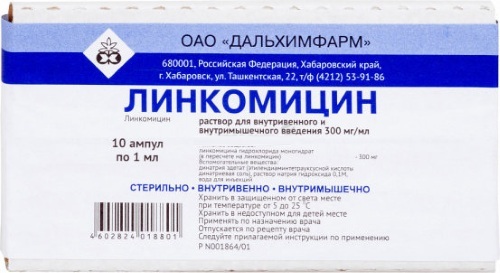
If you do not follow the dosage and recommendations of a specialist.
Then such undesirable manifestations can be observed:
- vomiting, flatulence, colitis, stomatitis, itching in the anus;
- leukopenia, neuropenia;
- allergic reaction;
- headache and dizziness;
- jaundice;
- tachycardia, hypotension;
- malfunctioning of the kidneys;
- vaginitis.
Do not use ampoules for children under 1 month, and capsules for up to 6 years. The drug is contraindicated for lactation and bearing of the fetus, meningitis, kidney and liver failure, intolerance to the constituent components.
The drug is freely available, the price of both forms varies from 100 rubles.
Zedex
This is a new generation antibiotic belonging to the group of cephalosporins, which has a bactericidal effect by inhibiting the synthesis of bacterial cells. As a result of this effect, the cells of microorganisms lose their ability to multiply, after which they quickly die. The medicine quickly and easily copes with the destruction of gram-positive and gram-negative bacteria.
The main substance is ceftibutene dihydrate, as well as auxiliary components cellulose, magnesium stearate, sodium carboxymethyl starch.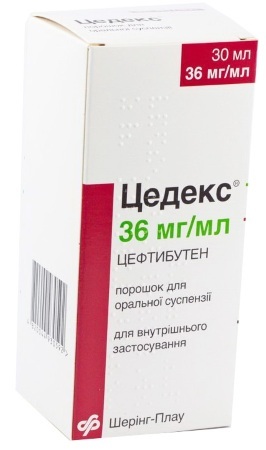
The drug is prescribed for such ailments:
- infections and inflammations that have been triggered by the presence of microorganisms sensitive to ceftibuten;
- pathology of the lower and upper respiratory tract;
- infections that have affected the genitourinary system of children and adults.
Capsules, and it is in them that the drug is produced, should be taken by adults and adolescents from 10 years old at 200-400 mg per day.
For children under 10 years of age, the dosage is calculated depending on body weight - 4.5-9 mg per 1 kg of body weight. The duration of therapy is set individually.
If you violate the established dosage and the recommendations of a specialist, then the following symptoms may appear: allergies, ringing in the ears, headache, convulsions, vaginitis, insomnia, anemia, flatulence, neuropenia, candidiasis.
Do not prescribe the drug to children under six months and people with intolerance to the composition of the drug. 400 mg capsules can be purchased without permission at any pharmacy for 1000 rubles.
Suprax
It is a semi-synthetic broad-spectrum antibiotic from the group of cephalosporins that has bactericidal properties. The drug is produced in the form of granules intended for the preparation of a suspension that gets into the body inhibits the synthesis of cells of the causative agent of infection and inflammation, slows down their reproduction and leads to their complete destruction.
The main component of the drug is cefixime trihydrate, as well as additional components: sodium benzoate, sucrose, xanthan gum, strawberry flavor.
The drug is prescribed for such pathologies:
- pharyngitis;
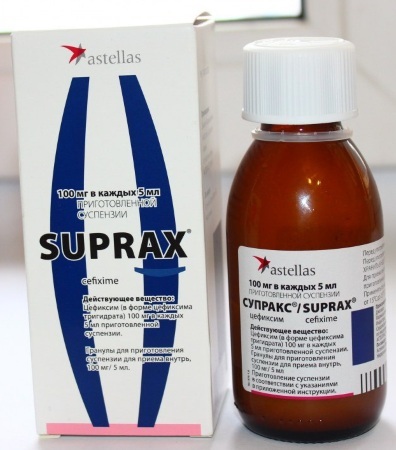
- tonsillitis;
- sinusitis;
- bronchitis in acute and chronic form;
- otitis;
- urinary tract infections;
- gonorrhea.
Take a suspension of 400 mg once a day or 200 mg twice a day. The course should not exceed more than 10 days.
For children under 12 years of age, the dosage is calculated as follows: 8 mg per 1 kg of body weight 1 time per day or 4 mg 2 times a day.
If the recommendations for admission are not followed, the following symptoms may be observed: anorexia, diarrhea, dry mouth, leukopenia, flatulence, dizziness, allergies, nephritis. Do not prescribe the drug to patients with special sensitivity to penicillins and cephalosporins. The drug can be bought in the public domain for 300 rubles.
Fortum
It is a new generation cephalosporin antibiotic with bactericidal properties. The active substance of the powder intended for the preparation of a solution for injection is ceftazidime, which inhibits the protein synthesis of the cells of pathogens.
The substance slows down, and then completely stops the process of reproduction of bacteria, which leads to their complete death. Carbon dioxide, sodium carbonate acts as additional components.
The drug is prescribed in such cases:
- the most severe infections, including intrauterine;
- infection of the ENT organs;
- inflammation and infection of the respiratory tract;
- infection of the skin and soft tissues;
- infections of the urinary tract;
- intestinal and stomach infections;
- infection of joints and bone tissue;
- infections directly related to the dialysis procedure.
The powder is used to prepare a solution for injection, injected into the body inside a vein or muscle. The dosage and course are selected individually, depending on the severity of the course of the disease. The maximum dose per day is 6 g, the frequency of administration is 2-3 times a day.
Among the undesirable manifestations, the following symptoms are more often observed: oral candidiasis, nausea, diarrhea, colitis, anemia, neutropenia, impaired renal function, phlebitis and thrombophlebitis, allergic reactions. You can not prescribe a drug with a special sensitivity to antibiotics of the cephalosporin series. The medicine is freely available at the pharmacy for 200 rubles.
New generation antibiotics, included in the list of 3rd generation drugs, must be selected by a specialist. Many drugs often cause unwanted manifestations and are contraindicated in people with serious pathologies.
Antibiotic videos
The mechanism of action of antibiotics:

